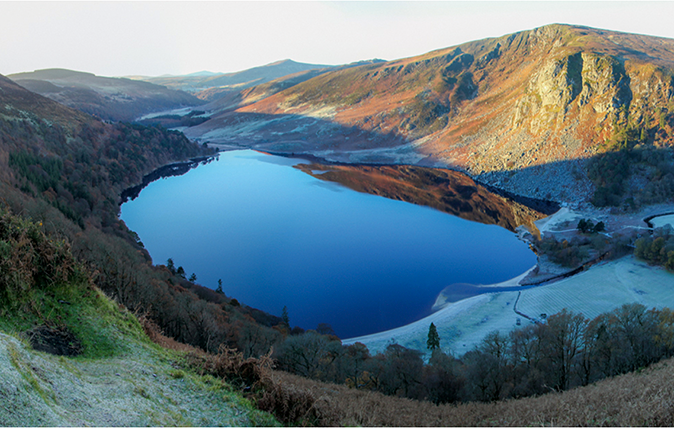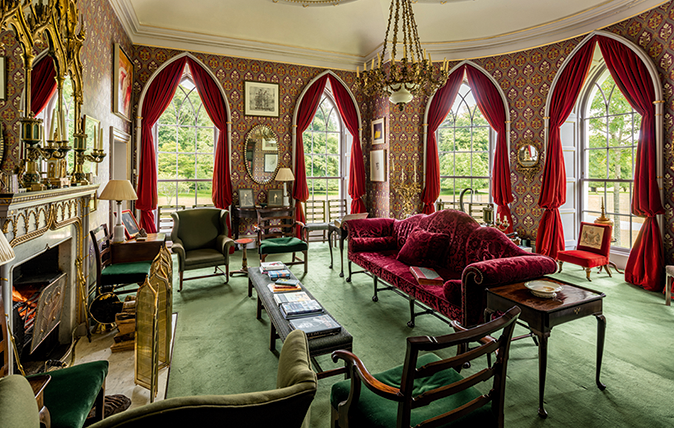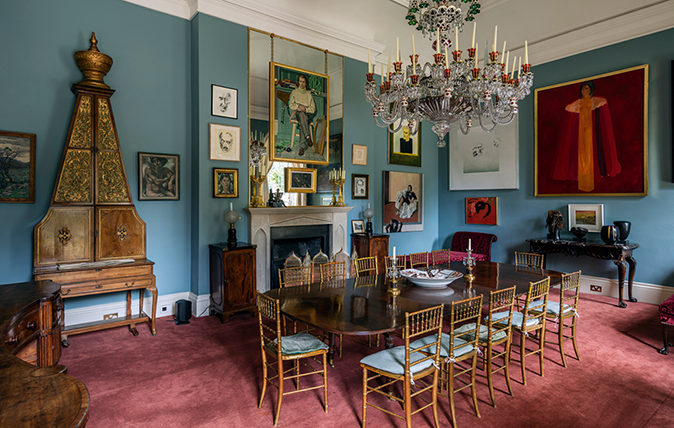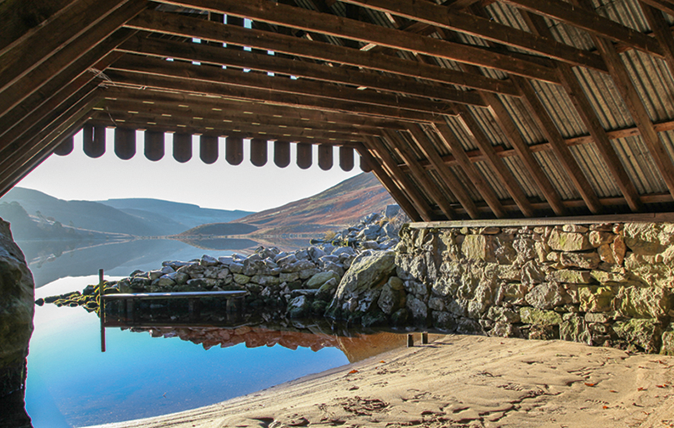The Guinness family’s incredible estate outside Dublin goes up for sale
Penny Churchill takes an in-depth look at one of Ireland's most astonishing properties: a vast and glorious estate just a few miles outside Dublin.


The launch onto the market of the hauntingly beautiful Luggala estate heralds the end of 80 wild and wonderful years of Guinness family ownership.
The property is near Roundwood, in the heart of the Wicklow Mountains, 28 miles south-west of Dublin, and is on the market at a guide price of €28 million (£23.8m) through Sotheby’s International Realty and Crawfords.
The first known account of the lodge at Luggala, whose Irish name means ‘hollow in the ridge’, comes in 1796, when the historian John Ferrar wrote about a ‘modern built house at Luggala agreeably situated between two mountains and extremely romantic. Fronting the house is a good piece of water, called Lough Tay… Nature has been bountiful to this spot, which is diversified with rocks curiously shaped, wood and waterfalls. The mountains abound with grouse, and the lough with fish, which brings many visitors to the place’.

One of those was the wealthy Irish banker Peter La Touche, whose passion for field-sports led him to buy the lands ‘replete with game’ at Luggala in the late 1700s, before going on to build himself ‘a handsome lodge in the early English style’, later described by the late Desmond FitzGerald, Knight of Glin, as ‘that special brand of eighteenth-century gothick that rejoices in little battlements, crochets, trefoil and quatrefoil windows and ogee mantelpieces: in fact the gothick of pastrycooks and Rockingham china’.
‘Somehow,’ he adds, ‘this whitewashed toy pavilion fits into its green-grey setting of old twisted oak-trees, beeches, mossy rocks and mountains in the most unnaturally natural way. Its very unlikelihood carries it off with a vivid panache.’
Panache came as standard during the Guinness era at Luggala, which began in 1912, when the Hon Arthur Ernest Guinness, having taken over the family’s Dublin brewery, rented the lodge and shoot at Luggala from Viscount Powerscourt, its then owner. The second son of Edward Guinness, created 1st Earl of Iveagh in 1919, Ernest, as he was always known, was a keen shot who invented his own short-barrelled shotgun for grouse, which were downed in their hundreds on regular shoots at the estate.

Having rented Luggala for 25 years, Ernest bought the 5,000-acre estate in 1937 as a wedding present for his youngest daughter, Oonagh, on her second marriage, to Dominick, 4th Baron Oranmore and Browne. Their marriage was dissolved in 1950.
Exquisite houses, the beauty of Nature, and how to get the most from your life, straight to your inbox.
According to film producer and screenwriter Michael Luke, who penned her obituary in The Independent in 1995, it was only after the Second World War and Oonagh’s second divorce that Luggala came into its own as ‘the most decorative honeypot in Ireland’. She made it the centre of a dazzling social world, and nobody, it seems, could keep away: ‘Dublin intelligentsia, literati, painters, actors, scholars, hangers-on, toffs, punters, poets, social hang-gliders were attracted to Luggala as to nowhere else in Ireland… And the still centre of this exultant, exuberant chaos was Oonagh.’
In 1970, Lady Oranmore transferred responsibility for the estate to her son, Dr The Hon Garech Browne, the founder with others of Claddagh Records, and the present custodian of Luggala. He not only maintained, but surpassed his mother’s tradition of lavish hospitality, while hosting and promoting Irish composers, poets and traditional musicians.

As Robert O’Byrne reveals in his supremely entertaining book Luggala Days: The Story of a Guinness House: ‘Guests were invited for drinks or dinner, only to emerge several days later blinking at the harsh light of the ordinary world, aware that during that lost period of time they had enjoyed themselves immensely without necessarily being clear about the details of how or why, or even with whom.’
Following a fire in 1956, the main block of Luggala was effectively left a ruin. However, it was swiftly restored in a joint effort by the architect Alan Hope and interior decorator John Hill of the Mayfair firm of Green & Abbott.
In 1996, a year after his mother’s death, Dr Browne embarked on a major, four-year-long refurbishment of the entire house, at an estimated cost of €4m–€5m. Dublin architect Sheehan & Barry oversaw the re-creation of the original arched windows, the reinstatement of chimneys and battlements to their correct height and scale and the re-creation of a long-lost wing on the north side of the courtyard.

Further largely invisible work included the installation of new electrical and plumbing systems. In addition, a new staircase – salvaged from an 18th-century house in Dublin – was installed to replace the unremarkable one fitted during the 1956 restoration. Similarly, the uninspiring drawing-room and dining-room chimneypieces were replaced by substitutes based on the pre-1956 originals, specially commissioned from Dick Reid of York.
Interior designers David Mlinaric and Amanda Douglas undertook the redecoration of the interior, their brief being to make the house look much as it had before: ‘the same, only different’. They sourced replicas of much of the original materials, such as the Gothic Lily wallpaper in the drawing room, originally designed by Pugin for the House of Lords. Other papers were printed by Irish specialist David Skinner.
Despite its relatively modest footprint, Luggala Lodge manages to contain three substantial reception rooms, plus a wealth of smaller rooms on both the ground and first floors. There are seven bedrooms within the main house, four within the guest lodge and a further 16 bedrooms within seven lodges and cottages scattered throughout the estate. For David Ashmore of Sotheby’s Realty, ‘Luggala is quite simply magnificent – a house that captures perfectly the picturesque in architecture, within an estate of a size rarely found in Ireland’.

The landscape at Luggala boasts one of the few remaining 18th-century landscaped gardens and includes two native Irish oak woods. No trees have been planted to interfere with the original La Touche landscape, apart from some conifers by the 7th Lord Powerscourt. Dr Browne learnt everything he knew about plants and trees from Alfred Williams, head gardener at the Browne family home, Castle MacGarrett, who came to Luggala with his mother, and from the 19th-century Irish gardener William Robinson’s seminal work The English Flower Garden.
This rustic stretch of the Garden of Ireland has long been the first port of call for advertising executives and TV location scouts when a scenic backdrop of rolling green hills and verdant valleys is required. The spectacular demesne has been the setting for numerous films including John Boorman’s Zardoz (1974) and Excalibur (1981), The Nephew (1998), King Arthur (2004), Astérix et Obélix (2012) and the popular TV series Ballykissangel and Vikings.
Summing up its impact on all those who spent time there over the years, the late actor Sir John Hurt, who starred in John Huston’s Sinful Davey (1967), also filmed at Luggala, said: ‘I’m not important to Luggala, but Luggala’s important to me.’
** Search for more properties for sale in Ireland **

